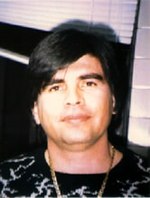

Benjamín Arellano Félix
| |
|---|---|
 | |
| Born | Benjamín Arellano Fèlix (1952-03-12) March 12, 1952 (age 72)[1] |
| Other names | Mín, El Señor |
| Occupation(s) | Tijuana Cartel founder and leader |
| Criminal status | Incarcerated at USP Lee |
| Children | 2 |
| Conviction(s) | Found Guilty |
| Criminal charge | Drug trafficking, money laundering, murder |
| Penalty | 25 years in a US federal prison |
Benjamín Arellano Félix (born 12 March 1952)[1] is a Mexican former drug lord who alongside his brothers founded and led the Tijuana Cartel or "Arellano-Félix Organization” until his arrest in March 2002.[2]
This section of a biography of a living person needs additional citations for verification. Please help by adding reliable sources. Contentious material about living persons that is unsourced or poorly sourced must be removed immediately from the article and its talk page, especially if potentially libelous.
Find sources: "Benjamín Arellano Félix" – news · newspapers · books · scholar · JSTOR (November 2019) (Learn how and when to remove this message) |
Benjamín Arellano Félix, who worked closely with his brothers, was one of Mexico's most powerful drug lords and the supplier of one-third of the U.S.'s cocaine.[2] Benjamín had six brothers:[citation needed]
He also has four sisters. Two of them, Alicia and Enedina, are most active in the cartel's affairs.[citation needed]
Benjamín was first arrested on 18 June 1982, in Downey, California, for receiving 100 kilos of cocaine smuggled through the San Ysidro border. However, he escaped custody.[4]
The Arellano Félix brothers obtained their first big break in 1989, when they inherited the organization from their uncle, Miguel Ángel Félix Gallardo, after they showed early promise smuggling consumer electronics over the U.S.–Mexico border.[2] By 1998, the Arellano brothers had been indicted in the U.S. for drug trafficking, and Ramón had been put on the FBI's 10 Most Wanted list.[citation needed]
Despite the brothers' audacity, they remained untouchable for 13 years. This was accomplished, in part, with large amounts of cash bribes to Mexican politicians and police commanders, at the cost of an estimated US$1 million per week.[2][5]
Benjamín Arellano tried to clear his name after the 1993 murder of Cardinal Juan Jesús Posadas Ocampo, in which he had been implicated. That high-profile assassination brought international attention to his trafficking organization and, although this forced Benjamín to lie low and adopt false names, he continued to live in casual confidence, apparently unafraid of capture.[2] He had a secret meeting with the Apostolic Nunciature to Mexico, Girolamo Prigione on December 1, 1993.[6] Another of Benjamin's brothers, Francisco, was arrested soon afterward on drug charges, and Benjamín, Ramón, and Javier officially became fugitives.[citation needed]
On 1 June 2000, the United States Department of the Treasury sanctioned Benjamín under the Foreign Narcotics Kingpin Designation Act (sometimes referred to simply as the "Kingpin Act"), for his involvement in drug trafficking, along with eleven other international criminals.[7] The act prohibited U.S. citizens and companies from doing any kind of business activity with him, and virtually freezing all his assets in the U.S.[8]
The U.S. DEA learned that Benjamín's oldest daughter had a very recognizable and rare facial deformity, and that she was the "soft spot" in her father's violent life. By tracing her, they found her father.[5] Benjamin was arrested on 9 March 2002 by the Mexican Army in the state of Puebla, Mexico.[9] He had a $2 million USD bounty for his arrest.[5]
Authorities are not sure where Benjamin's money went, beyond some real estate investments in Tijuana. Mexican officials say it has been invested in U.S. real estate, while their U.S. counterparts say much of it is hidden in cash in Mexico.
Benjamin was extradited to the United States on 29 April 2011 to face charges of trafficking cocaine into California.[10] On January 4, 2012, he pleaded guilty to racketeering and conspiracy to launder money, and was sentenced to 25 years in prison on 2 April 2012.[11]
Some objects that were confiscated from him during his arrests are on display at the Museo del Enervante in Mexico City.[12]
As of January 2023 Benjamin is incarcerated at USP Lee with a BOP Register Number of 00678-748. He is scheduled for release on April 28, 2032.[13]
In the 2017 Netflix and Univision series, El Chapo, Carlos Hernán Romo plays Benjamín Avendaño (a fictionalized portrayal of Benjamín Arellano Félix).
He is portrayed by Alfonso Dosal in the Netflix series Narcos: Mexico.
A 2003 Mexican film, El fin de los Arellano (The End of the Arellanos), featured characters supposedly based on the Arellano brothers; however, its plot bore practically no resemblance to the actual events.
The Arellano brothers were allegedly an inspiration for the two secondary characters of "the Obregón brothers", featured in the 2000 US film Traffic.